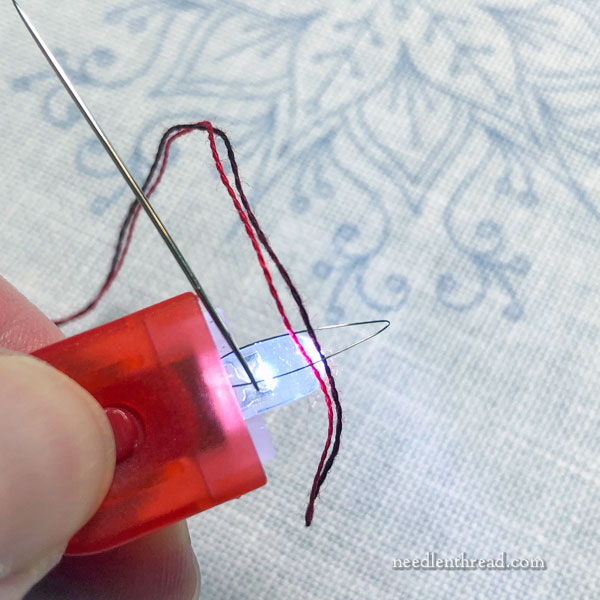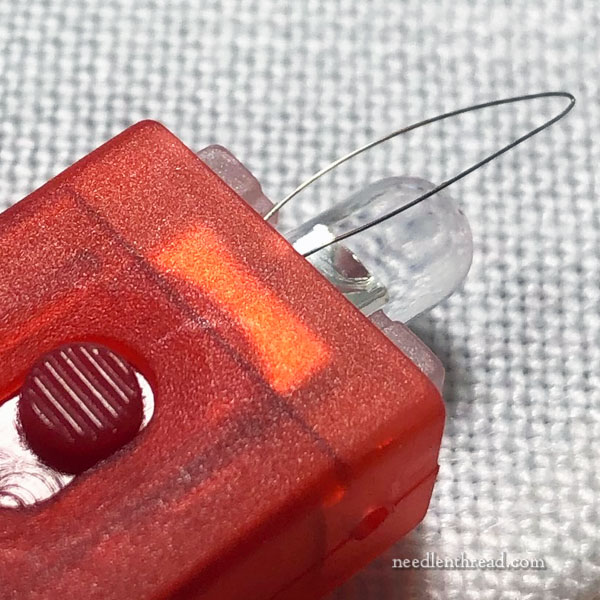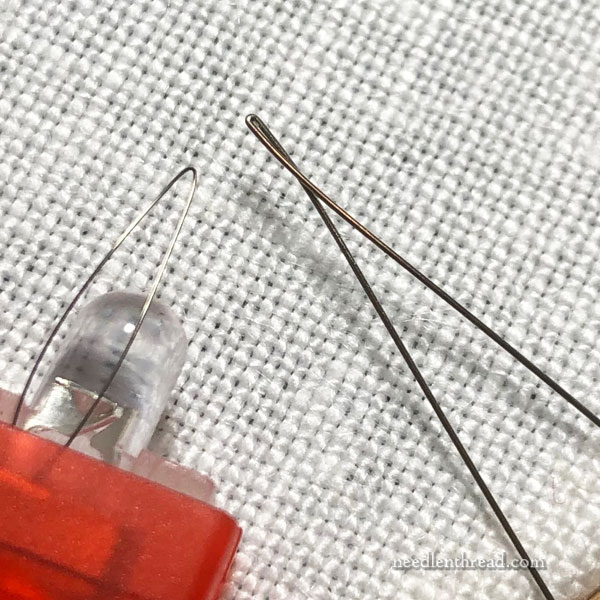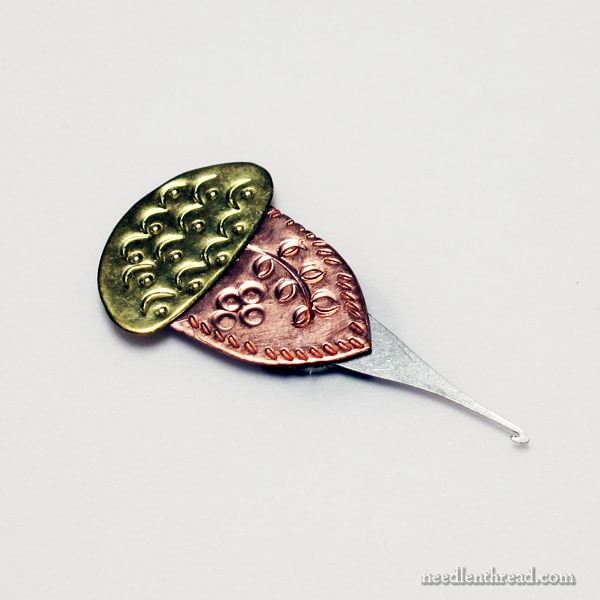I’m always looking for solutions to share with you, to make your embroidery life easier.
So when the conversation about a lighted needle threader popped up over in the Needle ‘n Thread Community on Facebook, I found myself exploring a topic that I think could come in handy for those of us who have rotten eyesight for whatever reason – or for those who struggle to thread needles for whatever reason!
One of the gals in the community (thank you, Pamela) posted a picture of a cheap little plastic needle threader that’s lighted, and asked if anyone had tried one. An engaging conversation pursued about different types of needle threading and threaders.
Being somewhat attracted to gadgets, my only take-away was that silly little threader. I have seen lighted needle threaders here and there – I think Dritz, among other companies, makes one – but the reviews are always pretty average or below average. So I never bothered. But this one, for some reason, was different. I had to try one of those little cheap plastic needle threaders! It became a kind of obsession.

The thing that sold me was the place where Pamela had come across the needle threaders.
It’s an online store called American Science and Surplus, and they always have weird, curious, overstock-type-things available. It’s not a site I often go to for shopping, unless I’m looking for something that I know they’re likely to carry, and to carry fairly inexpensively.
I’ve never thought of going there for embroidery-related goods. General purpose craft stuff – like sets of scissors and similar items – sure. Specifically embroidery-related supplies? Not really.
But I do go there sometimes just to read their zany product descriptions. Whoever writes them must have a lot of fun at work!
In any case, the needle threaders were inexpensive enough – three for $4.95 (unless you buy three – errrrr, that is nine – and then you get them for $4.45 for three).
Of course, there’s the shipping problem. But since I already had a couple things on there scoped out that I was planning on getting, I was ok with paying the shipping.

In any case, I bought the needle threader and I gave it the ol’ college try.
I’ve been using it, in fact, for about a week.
I’m always a little wary of thin-wire needle threaders like these, because the thin wire tends to pop off pretty quickly, but this little fellow’s holding up just swell.
It’s been handing two different sized needles well. I’ve been using it to thread a #10 ballpoint beading needle (which is small, indeed) with a single fine thread, and I’ve been using it to thread a #8 crewel needle with two strands of floss.
The light feature is nice. It does actually work. It lights up the eye of the needle. There’s a little on / off switch for the light, but even when it’s in the on position, the light isn’t always on. You have to squeeze the needle threader as you use it to turn it on. I think this is a good feature, because you can leave the little switch up and not waste the tiny battery hidden somewhere inside that thing.
There’s a cap that goes on the needle threader, too, to protect the wire when you’re not using it. I found the cap a little difficult to remove – I had to give it a serious heave-ho to get it off.
I might have even involved my teeth in the effort at one point. But then I realized it’s a matter of pinching the body of the threader and pulling the cap straight off.
I felt kind of dumb.
On the promotional video for the threaders (you’ll find it on the product listing I linked to above on the American Science and Surplus site) they show someone using the light part of the threader as an emergency flashlight while rummaging through the recesses of a purse in a dark room.
That might be going a bit overboard. The light on this thing does give off a tiny LED glow, but it’s not emergency lighting by a long shot, and I don’t see it working all that well for digging in the cavernous recesses of a purse while in a dark room (it looks hilariously questionable in that video – who are they marketing to, I wonder?)
They also show the charming little plastic threader attached via its cheap little carabiner to the zipper of a jacket – because, well – you know. Everyone wearing a jacket wants a cheap plastic LED needle threader hanging from its zipper. It’s a real statement of utilitarian fashion.
I just use it for the needle threader. I would probably recommend, should you explore these threaders, that you just use it for the threader, too.
And you know what? I like it. It works well, and it works with fine needles. I don’t know how long it’s going to work well, but for what it is and the price I paid for it, I like it.
Where to Find It
If you need something else from American Science and Surplus and you want to try the needle threader out, I’d just get them from there. The shipping makes them too expensive to buy alone, though, I think. It was $7-something to my house, but I had a few other things on my list from there, which all fell under that $7-something postage, making it more affordable.
If you look for the threaders on Amazon, they run $6 or $7 each, which is insane because they really are cheap little things.
I figure for the price of three on American Science and Surplus, I can have one for my work station, one to throw in a project bag, and one to hang on my jacket zipper so that I can go about stylin’ a needle threader, like the true fashionista that I am.

During our conversation on the Facebook group, the subject of threaders for those who make flies for fishing came up. I do have one of those – the top of it is pictured in the photo above on the right.
I don’t know if they come in other gauges of wire. I’m assuming they must, because this is such a heavy gauge that it makes the threader useless for any fine needles. It works ok on, say, a #22 (or even a #24) tapestry or chenille needle. It works ok on about a #5 crewel.
But I’ve found that, if I force it into a finer needle, it just shreds my threads to kingdom-come by the time I get them through the eye.
With needles that size, for me, the whole point of a threader is… pointless.
Part of the problem is that little cross-over on the tip. When you’re using cotton threads, threaders that cross over like that are not your best friend. As you pull the threader through the needle’s eye, especially if the needle is tight, the thread is forced down into that crossed part at the tip, where real havoc can happen. I always find that those crossed tip threaders chew up my threads.
That said, I’m going to look for finer gauge fly fishing threaders, because they are well made. If I ever find one that works on smaller needles, I’ll let you know!
Other Needle Threaders for Fine Needles
A while ago, I reviewed this micro needle threader from Puffin. I still like it! And I don’t hesitate to recommend it to those looking for small needle threaders.

I like the fact that it isn’t a wire threader.
There’s still the question of the little burr on the end of the hook (addressed in the article). I’ve heard from several people who have experienced that with these particular micro threaders. I buffed mine out, and it’s fine.
You?
If you have a favorite needle threader that works just great for you, why not chime in below and tell us about it? Your recommendation may be just the thing that keeps someone else out there happily stitching! Feel free to chime in on the conversation below!







I love the Puffin Micro threaders. The little burr is a nuisance. Mary – how did you buff yours out.
Japanese Embroiderer’s introduced me to
Red Dot threaders – they are used for fishing lures. Come in different weights.
I actually had my nephew do it with his dremel. I tried, but he did it better. LOL! I didn’t have the heavier buffing / sanding attachments.
I’ve sent photos by email, Mary.
Hi, Brenda – I don’t think I received them?
Your post this morning made my day. Seriously, they made a video for these threaders that are 3 for $5. I didn’t realize that they make threaders for making flies. Interesting.
American Science and surplus is a new website for me. My husband did electrical things so I only know about sites if you need a real flashlight.
Thank you for the posting.
I have a related question. I’ve been thinking about getting a needle minder for my 12 year old nephew. I’ve been teaching him to stitch, but we have to be together when he stitches because he is still having trouble threading the needle. He is currently doing cross stitch (18 count black fabric – oh to have young eyes) so it’s a tapestry needle. What do you suggest for a needle minder that I won’t lose my mind if he loses it?
I’d say just a pair of neodymium magnets? If you’re talking about a needle minder that stays on the surface of the fabric while he’s stitching….
Well, I’ve been wandering around American Science & Surplus for a while this morning and, you’re right, someone there is having a good time writing descriptions! Imagine looking at some of those things and trying to come up with a serious description! Thanks for the link and the laughs!
About needle threaders – I got a bunch of those cheap little threaders with the lady’s head on them (I think they were $2 for 100 or something like that). I put a drop of glue on each side of where the wire attaches to the holder and they last a good while. When they go bad, the wire usually breaks at the tip rather than falling apart at the holder. A little scrap-fabric sewing project is to make a pouch to hold several of them so they don’t get lost and are easy to toss in a project bag.
Dear Mary
The lighted needle threader looks like a useful accessory to own and very cheap in the USA but here in the UK they cost £6.47 for 1 at Amazon which as you say is expensive for a small item, you have got a bargain at 3 for $4.95. I have my pure light magnifier for when I thread my needles so I don’t really need a threader but it is useful and a great idea. Thank you for reviewing the lighted needle threader and for sharing your thoughts with us and for the photos.
Regards Anita Simmance
A very simple needle threader that can be used so long as the needle eye is a couple of millimetres long is a thin slip of paper, folded in half lengthwise. Hold the end of the thread in the fold, then slide the folded paper through the eye, pulling the thread through with it. This works really well with tapestry needles with both embroidery thread and wool. Hope this makes sense, it’s easier to see it than describe it. Always available and completely free!
I use the flat metal Lo -Ran threaders with a larger hook on one end and a smaller hook on the other for most of my work. I am annoyed as Lo-Ran changed from a magnetized version to a non-magnetized which means I lose them a lot! These don’t work for fine threads so I use my tiny Puffin or a wire. These all sort of work but I don’t see why some inventor couldn’t come up with perfect! Thanks, Mary, I might try yours, Charlotte Wells
I have 1 similar your acorn above and I dearly love it. Also I purchased in bulk (25) regular but decent quality wire threaders and I super glued the back where the wire attaches. I haven’t had to purchase any new ones for several years now. I also keep on my box a swatch of dull black construction paper because the contrast to the needle helps me see the hole easier.
Well thanks Mary! I just spent an hour (and almost $40) perusing the web site. You’re right, the informational blurbs are funny. But I got some Christmas gifts for kids in the family and a cover for my husband’s new BBQ grill, so it was time well spent….and enjoyed!
I use an Antique needle threader from REO – it is GORGEOUS. The aluminum, mass produced needle threader slips inside the REO holder, which makes the aluminum threaders much easier to hold and use. I usually have to cut the top of the threader so it will fit inside the holder, but it is so worth it! I love this because it is beautiful, and I can easily replace the actual threader when the wires break. Because it is only a little bigger than the aluminum threader, I punched a hole on the side and use a fob to help me keep from losing it. I love mine so much I bought some for my sister, daughter, and good friend who sews a lot. Here is the REO website https://reocompany.com/needle-threader-925-sterling-silver-antique-replica-embossed-sewing-tool/
I still like the small inexpensive wire one, I think it was probably one of the original kind invented. I like it mainly for threading quilting needles which have such a tiny eye quilting thread has a hard time going through it. I have also used it for embroidery but so far I have not had to use needle threaders for embroidery that much. When I open the pack the first thing I do is put a drop of super glue on both sides where the wire touches the main part, this seams to work well for me as before I was constantly breaking the wires but this trick seems to work well.
I am trying to do whitework on a preprinted fabric. I am having trouble covering the preprint lines with 2 strands of dmc or 2 strand of sulky 12 wt. any other suggestions?
Hi,Cynthia – you might try Coton a Broder, which is a thread really made for whitework, and it comes in different weights. Maybe a #20? You can find it on websites like lacis.com – search their catalog for “Coton a Broder”. It comes in white and ecru in different sizes, and then, in size #25, it comes in a whole range of colors.
Wait! Stop your order! There is another item at American Science and Surplus that is a MUST HAVE! It is a needle picker-upper! I use it all of the time. When I am sitting in my stitching chair and I drop a pin or needle, I pull out my trusty magnet-on-a stick and it magically – magnetically picks it up from the floor for me!
Item 93985P1 – Skinny But Strong Like Bull
Why is it named that? It looks like a pen but extends to two feet and picks up some pretty heavy items.,..even scissors!
Karen from Minnesota
Yes, I have one of them, too! Love it!!
I bought a gross of those really cheap aluminum needle threaders online. I’ve found that if you put a drop of super-glue on either side of the threader where the wire goes through it they last a pretty long time and are good for getting three strands of floss or up to a #8 perle cotton into a size 8 crewel needle, which is what I mostly use for smocking.
I pull out 4 or 5 at a time to treat with glue and then use those til they break or I lose them. I usually lose them first.
I have a tiny cat-shaped Puffin threader which I LOVE, but I keep it in a box on a shelf so I don’t lose it.
Love your sense of humor Mary!
Trish
Are they all red? Can you choose a color?
They have multiple colors. I know I got a green one too, but I can’t remember if there was another color in my group or not… :-/
Regarding needle threaders, they are the bane of my needlework efforts. LOL Any one with a wire constantly breaks and becomes a frustration. I bought one lighted one from Clover which was great as long as it lasted which was about one season. The Lorain hooks are fine for long eyed needles as are the DMC ones that are similar. However, the DMC ones include a wire loop that does not last very long. It would be nice if the wire ones could be made to last a little longer because they are the only kind the can work with hand sewing needles and finer eyed crewel needles.
I’m a fan of the Clover 8611, but it’s not without flaws.
I like that it can help thread multiple strands at once without damaging them.
I don’t like that the design of the whole thing relies on having two thin strips of metal remaining attached for the threader to work. Yank too hard and put too much pressure on the tip and yes, the tip will break open. Having done that, the threader becomes utterly useless.
At something like $10US each, it’s not cheap.
I guess I’ve learned the knack of using it so that the tip doesn’t become damaged, but I still regret that one hasty moment when I destroyed one.
My first lasted about six months, and would probably have lasted much longer if I hadn’t been so rough with it that one moment.
The second is going strong.
Oh, and the metal strip thing is too wide for smaller needles. Since I mostly cross stitch using fairly large needles (and I discovered the Mary Arden 28 petites that have large eyes) I don’t have trouble using it.
If most of my stitching was with small needles I’d give it a pass.
Me encanta como has descrito tu nueva adquisición!!!!. Y me parece muy interesante ese pequeño led. A veces es muy necesario iluminar bien cuando queremos enhebrar nuestra aguja. Yo me tengo que acercar mucho a mi lámpara de costura, y no siempre acierto a la primera.
Lo buscaré en mi país.
Particularmente uso esos enhebradores baratos y los no tan baratos. Y tienen muy poco uso, pues duran bastante poco.
Muchas gracias por traernos este pequeño indispensable.
I’m always looking for a better fine needle threader! The one tip I have – for the coin threaders, put a drop of strong glue (I used Gorilla Glue) on the back where the ends of the wires meet. It has made all the difference for me and they last much longer! For tapestry needles, I’ve relied on my LoRan for years. And I recently bought a Clover Double Needle Threader but I haven’t had a chance to try it yet. I really love the light up feature on these, it’s too bad they aren’t more widely available!
Hi Mary,
For the ‘invisible’ reweaving I do, I sometimes have to force a relatively thick thread thru a tiny needle. I use a looped human hair. This is lovely and fine and relatively strong. And always available!
Mary, thanks for the link to that surplus catalog, what a hoot!
I have had good luck with these clover threaders although not in super fine needles.
American Science and Surplus website is fascinating. Could spend hours and many dollars! Mary, thanks for the recommendation.
I am addicted to my green Clover threader but for a weird reason. They are the type that have a thin flat folded 1/8”(?) piece of metal that goes in the needle eye. I was always a bit irritated at how the thread went into the very tight end of the flat metal and took a tug to free. However…. about 2 years ago the tip broke on the fold! I kept using it while ordering another and realized that with the end tip now separated the thread still pulled through a good 1/4” but no more getting stuck!! It’s perfect now! You pull quickly and it does it’s job and pops off leaving about 1/4”-1/2” of thread pulled through the eye. Sometimes broken works better!!
What it’s a fly fishing needle for???
It’s actually not a needle that they thread – they’re bobbin threaders, for fly tying, which is basically the making of flies for fly fishing. They’re long, so that you can drag the thread from a spool through the “neck” or tube of a bobbin, which in fly tying, is the thing that holds the spool of thread so that you wrap hook shanks and whatnot with equally tensioned thread and other fuzzy stuff used to make flies for fishing. It can be tiny, tricky, fiddly work. But a few of the tools and supplies they use in fly tying cross over quite well into needlework – as do silk threads for fly tying!
If you’re fortunate enough to live near Chicago, you can visit the American Science and Surplus retail store in Geneva, IL. I’ve had some of their needle threaders, but I don’t use a threader regularly so can’t claim to know much.
Welllll…. if I pass through that way some day, it might even be worth going to visit the store. It seems like it would be a fun place to potter through! 🙂
I’d totally forgotten about them! I used to get their catalog, and it was hilarious. Years ago I got plain unmounted glass lenses for magnifying and reducing. The magnifier lenses came in higher power than you can normally find. The reducing lens is great for viewing items from “farther away” when you can’t actually back up that far. Say for viewing a quilt in progress. And I got some gear sets for DS when he was little (education disguised as play).
Uh oh – they have a containers section…. I may be in trouble!
I looked at the link and it says this
“Please note: Due to a sudden surge in demand, we are temporarily out of stock of this item. We are expecting our next shipment early next week and will ship out all backorders at that time. We apologize for any inconvenience this causes.”
Gee, I wonder why. 😉
Well, that’s good to know. I hope they don’t bring them in at a higher price. :-/
I know this post is almost a year old now, but I thought I would chime in anyway. Better late than never, right? One day I couldn’t get my needle threaded with the bulky yarn I was using, without destroying the yarn. Well, speaking of fly tying, which my husband does, I decided to use one of his larger fish hooks as a threader! After making sure I removed the barb, which would have wreaked havoc on the yarn, I slipped the hook through the needle, placed the yarn on the hook, and easily pulled the yarn through the needle. My husband was proud!